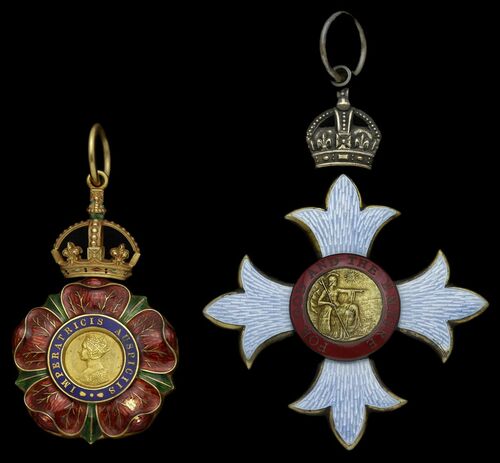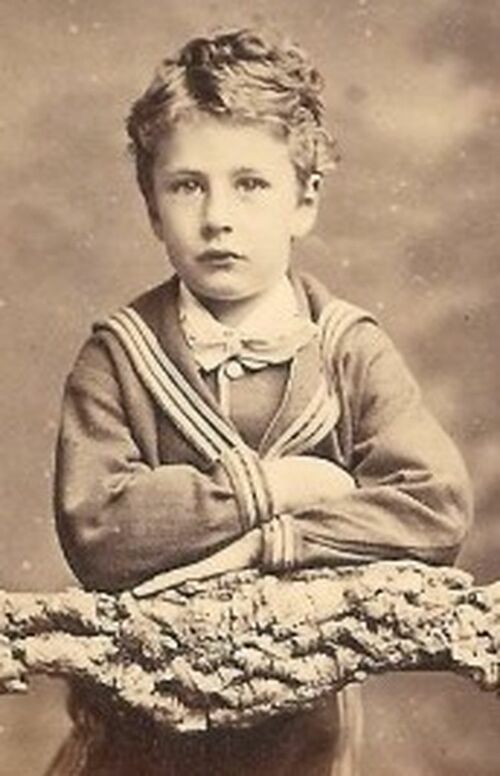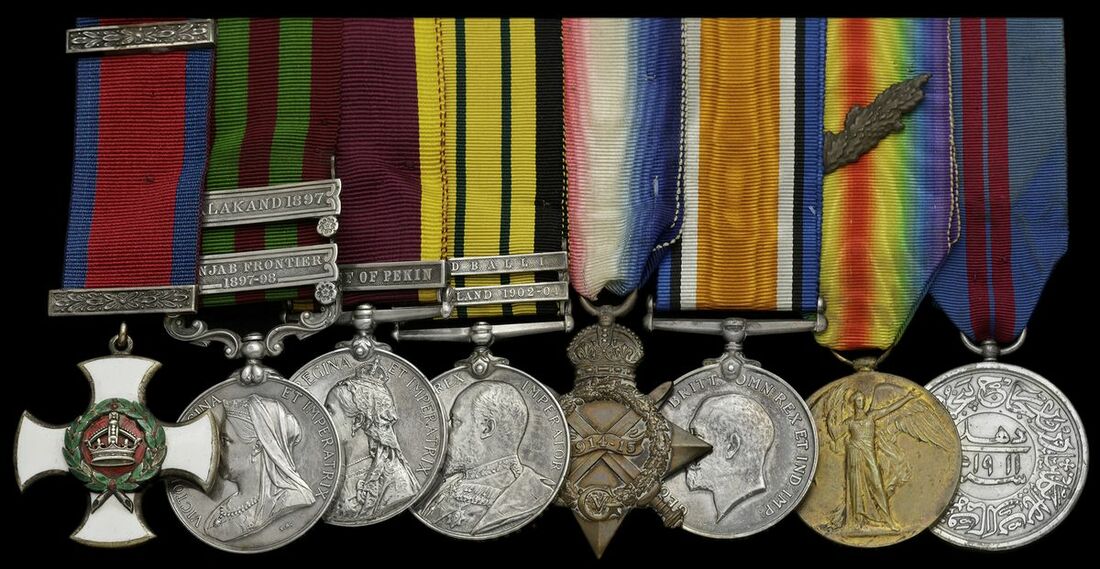Auction: 23001 - Orders, Decorations and Medals
Lot: 339
A superb C.I.E., C.B.E. and 'Malakand 1897' D.S.O. group of ten awarded to Lieutenant-Colonel A. K. Rawlins, 24th Punjabis and Bikaner Camel Corps, who was 'mentioned' on no less than five occasions in a career which spanned four campaigns
The Most Eminent Order of the Indian Empire, C.I.E., Companion’s 3rd type neck Badge, gold and enamel; The Most Excellent Order of the British Empire, C.B.E. (Military) Commander’s 1st Type neck Badge, silver-gilt and enamel; Distinguished Service Order, V.R., silver-gilt and enamel, top riband bar adapted for mounting; India General Service 1895-1908, 2 clasps, Punjab Frontier 1897-98, Malakand 1897 (Lieut. A. K. Rawlins. 24th Pjb: Infy.); China 1900, 1 clasp, Relief of Pekin (Capt. A. K. Rawlins. D.S.O. 24th Pjb: Infy.); Africa General Service 1902-56, 2 clasps, Somaliland 1902-04, Jidballi (Capt: A. K. Rawlins. D.S.O. 24th Punjabis.); 1914-15 Star (Maj. A. K. Rawlins, D.S.O. Bikaner Camel Corps.); British War and Victory Medals, with M.I.D. oak leaves (Lt. Col. A. K. Rawlins.); Delhi Durbar 1911, a little chipping to enamel on C.I.E., very fine (10)
C.I.E. London Gazette 25 August 1916.
C.B.E. London Gazette 1 January 1919.
D.S.O. London Gazette 20 May 1898.
M.I.D. London Gazette 5 November 1897 (Malakand), 2 September 1904 (Jidballi), 6 July 1917, 7 October 1918 and 22 January 1919.
Arthur Kennedy Rawlins was born on 15 May 1868 at Dharmsala, the son of Major-General James Sebastian Rawlins, a senior officer of the Indian Staff Corps, and Emma Augusta Wilmot Parke. Educated at Haileybury and the Imperial Service College, he was commissioned 2nd Lieutenant in the East Surrey Regiment in December 1889 and was made Lieutenant in the Indian Staff Corps in May 1892.
Into action - Subaltern's D.S.O.
Rawlins was thrown into his first campaign on the North-West Frontier of India in 1897. This part of his career is told best by Winston S. Churchill's The Malakand Field Force, which takes up the story of the attack on the camp in late July 1897:
'All this time the fire from rim into the cup had been causing severe and continual losses. The enemy surrounding the enclosure on three sides, brought a cross fire to bear on its defenders, and made frequent charges right up to the breastwork. Bullets were flying in all directions, and there was no question of shelter. Major Herbert, D.A.A.G., was hit early in the night. Later on Lieutenant-Colonel Lamb received the dangerous wound in his thigh which caused his death a few days afterwards. Many Sepoys were also killed and wounded. The command of the 24th Punjaub Infantry devolved upon a subaltern officer, Lieutenant Climo. The regiment, however, will never be in better hands.
At about one o'clock, during a lull in the firing, the company which was lining the east face of the enclosure heard feeble cries of help. A wounded havildar of the 24th was lying near the bazaar. He had fallen in the first attack, shot in the shoulder. The tribesmen, giving him two or three deep sword cuts to finish him, had left him for dead. He now appealed for help. The football ground on which he lay was swept by the fire of the troops, and overrun by the enemy's swordsmen, yet the cry for help did not pass unheeded. Taking two Sepoys with him, Lieutenant E. W. Costello, 24th Punjaub Infantry, ran out into the deadly space, and, in spite of the heavy fire, brought the wounded soldier in safety. For this heroic action he has since received the Victoria Cross.
As the night wore on, the attack of the enemy became so vigorous, that the Brigadier decided to call for a reinforcement of a hundred men from the garrison of the fort. This work stood high on a hill, and was impregnable to an enemy unprovided with field guns. Lieutenant Rawlins volunteered to try and reach it with the order. Accompanied by three orderlies, he started. He had to make his way through much broken ground infested by the enemy. One man sprang at him and struck him on the wrist with a sword, but the subaltern, firing his revolver, shot him dead, reached the fort in safety, and brought back the sorely-needed reinforcement.'
Rawlins was duly rewarded with his D.S.O. and a further 'mention' by Brigadier-General Meiklejohn:
'Lieutenant A.K. Rawlins has behaved well all through. I would recommend him to His Excellency for the plucky way in which he went to the fort on the 26th July to bring reinforcements, and again for the dash he showed in leading his men on the 27th and 28th, of which Lieutenant Climo speaks most highly.'
China & Africa Service
Rawlins was made Adjutant of the 24th Punjabis in 1899 and thence saw active service in China during 1900, and wrote to his brother to thank him for the parcels of supplies and to give his opinions of the combined international force which took to the field. It can be no surprise he listed the Native Indian Troops as the finest, followed by French, Germans, Russians and Americans with the Italian contingent bringing up the rear in his mind. He gave good insight into the makeup of his unit:
'I wish George could see our mounted Infantry, which consist of 50 men mounted on Chinese ponies & fitted out with the bandolier equipment. We have only organised them recently & they have proved most useful! I can assure you our Regts. have won the admiration of everybody, particularly the Germans & Americans who seem to have the most inquiring dispositions.'
Having been promoted Captain in December 1903, he also served in Somaliland and was present at the Battle of Jidballi, for which he earned another 'mention' besides another Medal & two clasps. It is worth noting that he served here with the Bikaner Camel Corps, his campaign award being issued from a special roll which has him as the only recipient of the silver Medal, with bronze Medals issued to his Bearer and Syce, the latter on campaign as his Private Servants.
Returned to India, Rawlins was posted for exploration work in Tibet, following the Younghusband Expedition of 1903-04. Taking a party from Gyantse, the group took in the great unmapped section of Tibet to the west of Shigatse, returning to India along the old Hindustan-Tibet Road. Having arrived safely at Simla, they could record the source of the River Sutlej which had been found far more westerly than previously considered. (The Argus, January 1905, refers)
Made a Company Commander in the 24th Punjabis in 1909, Rawlins joined the Imperial Service Troops soonafter and was re-united with the Maharajah of Bikaner, whose Camel Corps he would command during the Great War. During that conflict he initially served as a Special Service Officer (17 August 1914) and thence went to the Camel Corps. Rawlins later served in Salonika and the Russian Transcaucasia, being further 'mentioned' on several occasions and adding the C.I.E. and C.B.E. to his laurels. Retired in 1921, the Lieutenant-Colonel died on 16 November 1943; sold together with copied research.
Subject to 20% VAT on Buyer’s Premium. For more information please view Terms and Conditions for Buyers.
Sold for
£10,000
Starting price
£3500









